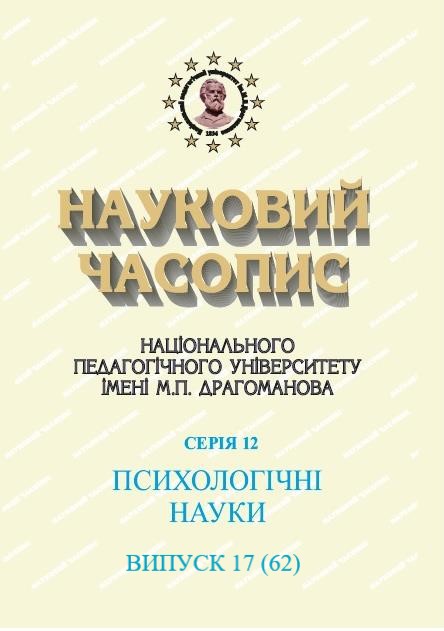PECULIARITIES OF ART THERAPY APPLICATION IN FEAR CORRECTION AMONG CHILDREN OF PRIMARY SCHOOL AGE
DOI:
https://doi.org/10.31392/NPU-nc.series12.2022.17(62).11Keywords:
art therapy, adaptation, integration, correction, compensation, fear, anxiety, primary school age.Abstract
The article analyzes the general approaches to the problem of art therapy application peculiarities for younger students with destructive emotional development and fears. Various scientific approaches to the interpretation of the term “children’s fears” are presented, the meaning of which emphasizes the need for real help to children of this category in the educational process, providing support and opportunities for self-realization in the process of integration into society. It is established that the psychological features of the genesis and fears of younger students is the dependence of emotional and development of the child from external and internal factors influencing it. It is stated that the formation of fears and negative emotional symptoms of junior high school students occurs on the basis of personal tumors of this age. As a correctional-therapeutic-rehabilitation technology in dealing with children’s fears, we propose to use music art therapy – an innovative educational technology “treatment” by means of art for the harmonious development of the child’s personality problems in the emotional sphere. Theoretical research and analysis of fear manifestation peculiarities among the children of primary school age indicate the need for special psychological and pedagogical work to optimize the personal and emotional sphere of children. Taking into account the peculiarities of the current level of fears and anxiety in children, we have developed an algorithm for conducting art therapy classes with children of primary school age. It consisted of six stages, each of which is determined by the peculiarities of the child’s adaptation to interaction with the social environment, as well as the difficulties that children experience in the school process. During art-therapeutic classes, we adhered to the principle of continuity, ensuring the integrity and systemic nature of psychological influences.
References
- Bandura, A. (2012). Teoriia sotsialnoho navchannia [Theory of social learning]. Kyiv : Lybid [in Ukrainian].
- Art-terapevtychni tekhniky u roboti praktychnoho psykholoha: rekomendatsii shchodo vykorystannia art-terapevtychnykh tekhnik u roboti praktychnoho psykholoha zakladiv osvity [Art-therapeutic techniques in the work of a practical psychologist: recommendations for the use of art-therapeutic techniques in the work of a practical psychologist of educational institutions]. Received from: https://static. klasnaocinka.com.ua /.../art_terapiya_u_roboti_ psiholo [in Ukrainian].
- Bekh, I. (2003). Vykhovannia osobystosti: Osobystisno oriientovanyi pidkhid: teoretyko-tekhnolohichni zasady [Education of personality. Personality-oriented approach: theoretical and technological principles]. Book 1. Kyiv : Lybid. [in Ukrainian].
- Vainer, M.E. (2014). Korektsiia nekonstruktyvnoi povedinky shkoliariv za dopomohoiu hry [Correction of unconstructive behavior of students through play]. Pochatkova shkola – Primary school, 1, 59–67 [in Ukrainian].
- Vietrova, O.Ye. (2005). Psykholoho-pedahohichnyi pidkhid do vyznachennia poniattia «strakh» [Psychological and pedagogical approach to the definition of “fear”]. Pedahohichna osvita ta nauka – Pedagogical education and science, 8, 37–41 [in Ukrainian].
- Vlasiuk, M. (2005). Art-terapiia: ztsilennia mystetstvom [Art therapy: healing by art.].
Psykholoh – Psychologist, 39, 9–23 [in Ukrainian]. - Hrinova, O.M. (2015). Osoblyvosti vykorystannia muzykoterapii v roboti z doshkilnykamy [Features of the use of music therapy in working with preschoolers.]. Praktychnyi psykholoh: Dytiachyi sadok – Practical psychologist: Kindergarten, 10, 25–31 [in Ukrainian].
- Voznesenska, O. (2007). Art-terapiia v roboti praktychnoho psykholoha: vykorystannia art-tekhnolohii v osviti [Art therapy in the work of a practical psychologist: the use of art technology in education]. Kyiv : Shkilnyi svit [in Ukrainian].
- Pantiuk, T.I. (2019). Osnovy korektsiinoi pedahohiky: navchalno‐metodychnyi posibnyk (2‐he vydannia, dop. i pererob) [Fundamentals of correctional pedagogy: textbook (2nd edition, supplemented and revised)]. Drohobych : Redaktsiino‐vydavnychyi viddil DDPU [in Ukrainian].
- Soroka, O.V. (2003). Korektsiia strakhiv metodamy art-terapii [Correction of fears by methods of art therapy]. Kyiv : Lybid [in Ukrainian].
- Tararina, O.V. (2017). Hlybynna art-terapiia: praktyky transformatsii [Deep art therapy: practices of transformations]. Kyiv : Astamir-V [in Ukrainian].
- Tararina, O.V. (2018). Praktykum z art-terapii v roboti z ditmy [Workshop on art therapy in working with children]. Kyiv : Astamir-V [in Ukrainian].
- Terletska, L.H. (2016). Psykholohiia zdorovia: art-terapevtychni tekhnolohii: navch.pos [Psychology of health: art-therapeutic technologies]. Kyiv : Vydavnychyi dim “Slovo” [in Ukrainian].

